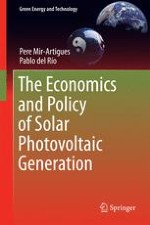
2016 | OriginalPaper | Chapter
1. Introduction
Authors : Pere Mir-Artigues, Pablo del Río
Published in: The Economics and Policy of Solar Photovoltaic Generation
Publisher: Springer International Publishing
Activate our intelligent search to find suitable subject content or patents.
Select sections of text to find matching patents with Artificial Intelligence. powered by
Select sections of text to find additional relevant content using AI-assisted search. powered by